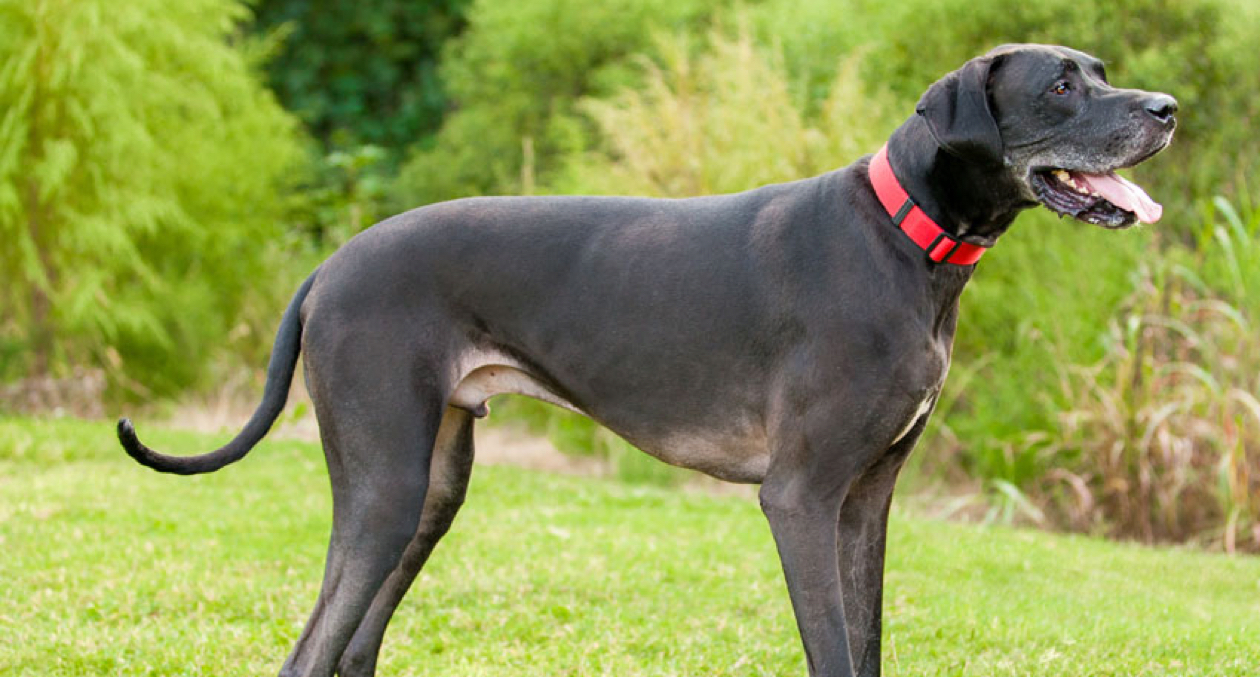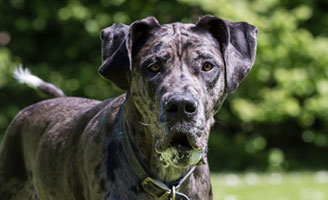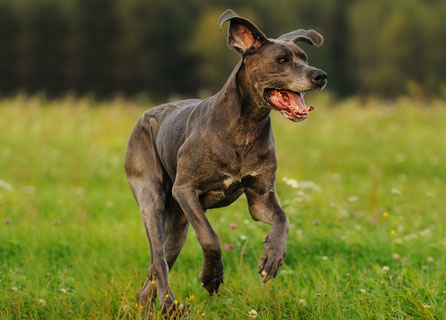
Great Dane breed guide
Large, elegant and loyal dogs, Great Danes make a fantastic addition to the family. Learn more about this easy-going, gentle giant, from their grooming and exercise needs to the things you can do to keep them happy and healthy.
Breed information and advice
Friendly and affectionate, the Great Danes are from the working breed group and have a relaxed and patient personality that makes them a wonderful family pet. Here's more you should know:
- Great Danes need a big living space with access to a large garden and will require more than two hours of exercise each day once fully grown.Great Danes need a big living space with access to a large garden and will require more than two hours of exercise each day once fully grown.
- Their coat is short, thick and smooth and regular grooming is recommended to keep them in good condition.Their coat is short, thick and smooth and regular grooming is recommended to keep them in good condition.
- This dog typically weighs between 45kg and 90kg when fully grown.This dog typically weighs between 45kg and 90kg when fully grown.
- A healthy Great Dane could live between 6 and 10 years.A healthy Great Dane could live between 6 and 10 years.
Typical size of a Great Dane: Large - 71cm-86cm

Recommended exercise and nutrition
Despite their enormous size, Great Danes are actually much happier as indoor family pets. They're easily house-trained and well-behaved if socialised from an early age. Older dogs will be content with one or two walks a day, but puppies tend to be more energetic.
Great Dane puppies will grow for around 18 months, during which time your pet will need special large breed puppy food to help them grow at a healthy pace and allow their bones to form properly. Puppies will need their food split over three meals, while adult dogs will need feeding twice a day. Always consider your dog’s size, age and gender for appropriate measurements and read the packet instructions.
More than two hours of exercise per day
Take care to control your dog’s exercise as a puppy when their bones are growing, but once fully grown this gentle, people-loving pet will need a good amount of exercise to keep them fit and healthy.

Common health problems and illnesses
Your Great Dane will need all of the usual vaccinations and check-ups to help protect him against common ailments. There are some conditions which this breed is more prone to though, and you may want to familiarise yourself with the symptoms or signs, so you know what to look out for.
From about the age of four, Great Danes have a greater risk of heart disease, specifically canine dilated cardiomyopathy. This is when the chambers of the heart enlarge and the heart muscle thins, reducing the heart’s ability to pump the blood effectively. This condition often shows no obvious signs initially and if undetected, sadly it can cause sudden death. Signs to be aware of include your dog being reluctant to exercise, experiencing breathlessness and coughing. Make sure your dog has a heart check-up at least once a year. Heart scans can be performed to check for this condition and if diagnosed, your vet will be able to advise on medications to help treat it.
Osteosarcomas, or bone tumours, are often seen in this breed, particularly in older dogs. Lameness, swelling on the affected leg and your dog appearing to be in pain, are the signs to be aware of. These cancerous tumours can spread to other areas of the body, so it is really important to let your vet examine any limb which is swollen or painful, especially if your dog’s leg has been previously injured.
If this occurs, it is an emergency situation where the dog’s stomach is filled with gas. The condition can cause the stomach to twist and if so, will require immediate surgery. If you notice any bloating around the stomach, dribbling or your dog is anxious, pacing and trying to vomit, then contact your vet. To help prevent this condition, you could split your dog’s food over several servings, raise their dog bowl and avoid any exercise after meals.
Lameness is a genetic developmental disorder seen in Great Danes, so this breed is susceptible to torn knee ligaments and hip dysplasia, where the hip joints don’t fit together properly. As puppies, some Great Danes experience hypertrophic osteodystrophy, a bone inflammation that affects the front legs during the growth stage. If you spot any unusual changes in your dog’s movement then speak to your vet, who will be able to diagnose the condition and recommend the most appropriate course of treatment.
Great Danes can also develop mast cell tumours - these cancerous tumours are graded depending on their severity and they look like harmless warts. Keep an eye out for any unusual swellings, rashes or changes to the skin when grooming, and your vet will advise you on the most suitable treatment options.
Find out about insurance for your Great Dane
Learn how pet insurance works and what kind of cover you might need for your dog.
Grooming advice
A weekly grooming routine, along with a regular bath, is more than enough to keep your Great Dane looking their best. They'll enjoy the fuss and it’s a fun way to bond.
This breed has a short, thick coat and doesn’t shed much - however, given their size, this can still mean a lot of hair on clothes and couches. Using a grooming mitt or soft-bristled brush once a week will usually be enough to keep their hair and skin in good condition. In spring and autumn, they'll have a heavy shed and will need more frequent brushing to get rid of all the excess hair.
Every week check their nails, ears and teeth. Trim their nails as needed to prevent them from cracking or snagging. Try to keep their ears clean and dry, and brush their teeth daily to help keep their mouth clean and healthy and to prevent dental problems. After each walk (especially in the winter), clean and dry their feet and check the pads and in between the toes for any problems.
Fun and interesting facts
- Despite their name, this breed is not from Denmark. They are thought to have been bred for boar-hunting in Germany, from Irish Wolfhounds and English Mastiffs.
- Although this dog continues growing for a long time, initial growth is very fast, and their weight will go from 45-90g to over 45kg in just six months.
- The world’s tallest dog was a Great Dane called Zeus from Michigan. He measured 1.12m to his shoulder and stood an astounding 2.24m on his hind legs.
- Cartoon favourite Scooby Doo was a Great Dane. This might have been because in medieval times, the breed was said to protect homes against ghosts and evil spirits.
- Great Dane Just Nuisance was a companion of sailors in South Africa during World War II, travelling alongside them. He became the only dog to ever have been enlisted in the Navy.
Important information
The content on this page aims to offer an informative introduction to pet breeds, but does not constitute expert veterinary advice. If your dog or cat falls ill or has an injury, contact your vet immediately.
All facts and figures were correct at date of publication and were compiled using a range of sources.
Discover more breeds
Browse our other cat and dog guides to learn about some of the UK’s most popular breeds.